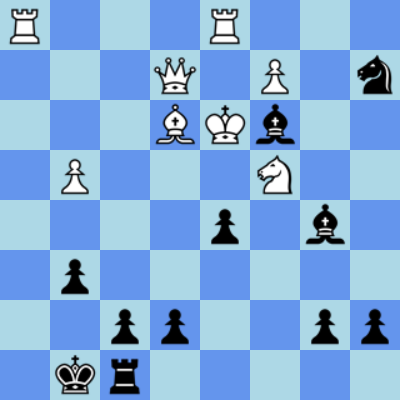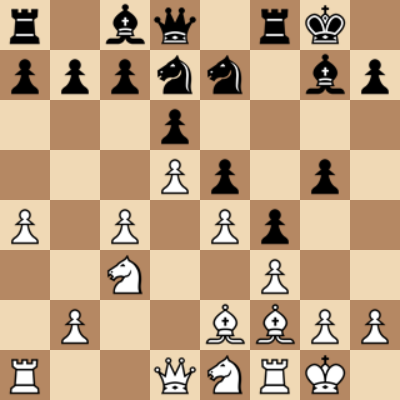React Chess Board v0.4.9

Yet another Javascript chessboard.
Intended to be used as a pluggable component in projects constructed using React.js and involving chess games.
Install
Through npm
cd your-react-project-folder npm install --save next-chess-boardor through yarn
cd your-react-project-folder yarn add next-chess-boardYou are ready to use ChessBoard component in your react.js project, for instance in your index.js:
<div> <Chessboard size=400 moveValidator=true /> </div> Motivation
In spite of the fact that there are many fine alternatives around, it's somewhat difficult to find one that offers a good mix of functionality and aesthetics. This work began with this idea in mind, and the result is a web chessboard that features:
-
Performing moves through mouse clicks or mouse dragging of the figures. Most alternatives offer one way or the other, some of them let the user choose operating mode, and ... oh! there is also ICC web interface special case that not only uses dragging, but also pops up an annoying JQuery UI dialog in the middle of your blitz game! if you accidentally click twice on the board. All of this is solved by Next Chess Board. The user can click and/or drag and the component will behave consequently.
-
Seven chess figures sets to choose from .
-
Four differnet board backgrounds.
-
Four different working modes: setup, analysis, play and view.
-
A smart promotion panel that detects the promotion square and sits directly on it, sparing the player a long movement with the mouse to choose the promoting figure. It also detects color of the figures and background of the the square, "dressing" itself with those options, providing a clear visual clue of the action that's undergoing.
-
Importing/exporting of FEN positions and PGN games.
-
Exporting the board to image (as of now, PNG format), using the function
drawDiagram -
Loads of other minor but useful features.
API
Main recomendation here is the old, wise Use the source, Luke
The client pages, users of the component, may be found in the /pages directory of the source. There almost every feature this component provides is used, and the code is pretty self explanatory. Looking at them (and reusing code!) is strongly recommended.
Anyway the formal description follows.
Static properties and methods
static Modes = {
MODE_SETUP: 'MODE_SETUP',
MODE_ANALYSIS: 'MODE_ANALYSIS',
MODE_VIEW: 'MODE_VIEW',
MODE_PLAY: 'MODE_PLAY'
}
Define the 4 modes that ChessBoard can adopt.
Chessboard.chessSets Exposes an array of image sets in data format, which is used internally by the board to draw its images. This means that the user of the component doesn't have to care about figure images location, since they are embedded within the component itself. Exposing them publicly through this property allows their usage outside of the chessboard, for example:
static Messages = CHECK_MATE: en: 'Checkmate' es: 'Jaque Mate' CHECK: en: 'Check' es: 'Jaque' STALE_MATE: en: 'Stalemate draw' es: 'Tablas por mate ahogado' INSUFFICIENT_MATERIAL: en: 'Draw for insufficient material' es: 'Tablas por material insuficiente' WRONG_MOVE: en: 'Wrong move' es: 'Movimiento incorrecto' ERROR_LOAD_FEN: en: "Could not load position" es: "No se pudo cargar la posición" ERROR_PREV_POS: en: "Attempt to move from a non last position" es: "Intento de mover desde una posición que no es la última" ERROR_MOVE_ARGS: en: "Move called with wrong number of arguments" es: "Función 'move' invocada con número incorrecto de argumentos" ERROR_MOVE_TURN: en: "Attempt to move the wrong color" es: "Intento de mover el color equivocadd" ERROR_CANT_PROCESS_SAN: en: "Can't process standard algebraic notation (SAN) move without a move validator" es: "No se puede procesar movimiento en notación algebraica estandard (SAN) sin un validador de movimientos" ERROR_WRONG_MOVE: en: 'Wrong move' es: 'Movida errónea' These are the messages that ChessBoard internally uses to provide feedback to its client page. As it shows, it's an array of objects, each one of them providing a string message in English and Spanish (would be good to have some more languages, contributors anywhere?) . It's up to the client page to choose the proper one according to its settings. Example of this can be seen in the message handliers implemented in index.js which provides for the home page at the demo site. It can be found under the /pages directory of the source. It's strongly recommended to have a thorough look at it, as it shows almost all the features depicted here.
static Figurines = p: codePoint: '0x265f' html: '♟' n: codePoint: '0x265e' html: '♞' b: codePoint: '0x265d' html: '♝' r: codePoint: '0x265c' html: '♜' q: codePoint: '0x265b' html: '♛' k: codePoint: '0x265a' html: '♚' P: codePoint: '0x2659' html: '♙' N: codePoint: '0x2658' html: '♘' B: codePoint: '0x2657' html: '♗' R: codePoint: '0x2656' html: '♖' Q: codePoint: '0x2655' html: '♕' K: codePoint: '0x2654' html: '♔' Codes for figurines in utf8 and html. Reserved for future use.
static ChessBoard static ChessBoard static pos static sqBgLabels = 'Blue' 'Brown' 'Acqua' 'Maroon' static lightSqBgs = '#add8e6' '#f0d9b5' '#dfdfdf' '#FFF2D7' static darkSqBgs = '#6495ed' '#b58863' '#56b6e2' "#B2535B" static selectedSqBg = '#bfd' static emptyPosition = ChessBoard static defaultPosition = 'rnbqkbnrpppppppp00000000000000000000000000000000PPPPPPPPRNBQKBNR' static sicilianPosition = 'rnbqkbnrpp0ppppp0000000000p000000000P00000000000PPPP0PPPRNBQKBNR' static emptyFen = '8/8/8/8/8/8/8/8 w - - 0 1' static defaultFen = 'rnbqkbnr/pppppppp/8/8/8/8/PPPPPPPP/RNBQKBNR w KQkq - 0 1' static sicilianFen = 'rnbqkbnr/pp1ppppp/8/2p5/4P3/8/PPPP1PPP/RNBQKBNR w KQkq - 0 1' static pgnTagLineRE = /^\s*\[\s*\s+""\s*\]\s*$/ static sanRE = /?$/ static defaultSettings = size: 400 flipped: false chessSet: 'default' currentPosition: 0 positions: ChessBoarddefaultFen lightSqsBg: ChessBoardlightSqBgs0 darkSqsBg: ChessBoarddarkSqBgs0 selectedSqBg: ChessBoardselectedSqBg movements: isCrowning: false showNotation: true whitePlayer: 'White Player' blackPlayer: 'Black Player' lang: 'en' All of the above should be pretty self explanatory
Instance methods
To be invoked to perform a particular action on a selected instance, for example, to flip the board:
extend Component { return <div> <ChessBoard ref="board1" size=400 moveValidator=true /> <button onClick= thisrefsboard1> Flip it! </button> </div> }List of available instance methods
-
setup() Puts the board in setup mode, making the setup panel visible and hiding the notation panel
-
analyse() Puts the board in analyse mode, in which the user cand od basically anything that involves a legal chess move, including undoing
-
view() Puts the board in view mode, in which the user can browse the game, but isn't allowed to alter the game by any mean
-
play() Puts the board in game mode, which allows him to move when it's her/his turn
-
flip() Flips/Unflips the board. Shortcut: this function can be invoked by double-clicking the board in any mode
-
setSize(newSize) Sets board size to newsize
-
drawDiagram(context, ctxSize = this.state.size) Copies board position to a canvas where it may be treated (copied, saved) as an image. Second argument corresponds to canvas size. If it is omitted defaults to board size, which implies that canvas may remain partially unused if it is larger than board, or that board image won't fit in entirely in the opposite case. Recommended setting is passing in canvas size
-
doScroll() Auxiliary function to scroll notation panel to the bottom. Imperative (smells)
-
useSet(set) Defines shape for figures being shown. Available values for set are: 'default', 'alt1', 'modern', 'fantasy', 'spatial', 'eyes' and 'veronika'. Feel free to roll your own
-
useSquares(n) Defines color for light and dark squares on the board. There are currently 4 schemas available (0, 1, 2, 3, 4) a.k.a. ('Blue', 'Brown', 'Acqua', 'Maroon'). Take on account, however, that the function must be invoked with a numerical argument. For instance,
board.useSquares(1)gives you these board colors
-
goto(n) *Sets the board position to n and consequently redraws it to reflect the new position, where n should be a number between 0 and
positions.length - 1. But regardless, ChessBoard won't allow going off boundaries. -
previous()
-
next()
-
last()
-
first() 4 convenience methods to move to previous, next, last and first position respectively. They call
goto()under the hood. -
empty() As the name implies, it just empties the chessboard
-
reset() Resets the board, cleaning the positions and movements arrays, and sets it to
ChessBoard.defaultFen -
loadFen(fen) Reads a string in Forsyth Edwards notation and attemps to make it the current first position
-
loadPgn(pgn) Reads a string in Portable Game Notation and attempts to load its data and all the moves in the current game. Requires
moveValidator={true}in the properties for this to work -
takeback() Undoes last move. Not to be used in play mode.
-
move(...args) the essence of the whole thing, performing moves, where ...args is an array of arguments with a number that can be: a. 1 = move in Standard Algebraic Notation. moveValidator must be true for this to work b. 3 = sqFrom, sqTo, figure. This is the way ChessBoard uses to perform moves in response to user actions c. 4 = sqFrom, sqTo, figure, promotion. Same as previous, with promotion special case. sqFrom and sqTo are numerical, while figure and promotion are string representation of the figure being moved or promoted to respectively
-
isFlipped() Just lets the client know if the board is flipped (just in case the client is not human and/or can't see :-)
-
setHeader(k, v) Sets game header k to value v. For example:
game.setHeader('Place', 'Rosario') -
setDate(date)
-
setDate(date) Shortcut for
board.setHeader('Date', date) -
setPlayer(color, name) Shortcut for
board.setHeader('White|Black', name) -
getPgnText() Retrieves current game in PGN format
Events
The chessboard uses its own event system in order to communicate the components/pages that host it when something important has happened on the board, be it related to the game itself or otherwise.
List of events that ChessBoard publishes
- CHECK_MATE
- CHECK
- DRAW
- STALE_MATE
- INSUFFICIENT_MATERIAL
- MOVE
- ERROR
- CHANGE
- FLIP
List of Messages associated to ChessBoard events
- CHECK_MATE
- CHECK
- STALE_MATE
- INSUFFICIENT_MATERIAL
- WRONG_MOVE
- ERROR_LOAD_FEN
- ERROR_PREV_POS
- ERROR_MOVE_ARGS
- ERROR_MOVE_TURN
- ERROR_CANT_PROCESS_SAN
- ERROR_WRONG_MOVE
Each one of the previous messages is an object which - as of now - contains two keys: en and es, each one of them containing the corresponding message in English and Spanish respectively. It would be nice to add italian, french, german, russian and portuguese to begin with, and to continue with other national languages. That's a task that will be undertaken in the near future, as long as we get some contributors who are up to the task.
Usage of ChessBoard event system
The clients (usually pages that host the board) shall subcribe to the events they're interested in, feeding ChessBoard with the desired event and a callback function that will be invoked when the event is fired/emitted by ChessBoard. In response ChessBoard will return a function that will cancel the subscription upon invocation. A typical scenario is subscribing to the event/s in componentDidMount, and unsubsribing in componentWillUnmount, like so:
{ thisunsubsCheckMate = board1 }} { this // Cleaning up before leaving}Looking at the way this is done in /pages/index.js of the demo project is strongly encouraged.
Todo:
- Embelishing
Technology
This project was bootstrapped with Create Next App.
Find the most recent version of this guide at here. And check out Next.js repo for the most up-to-date info.
Copyright
The present software is subject to the terms of the MIT license, as stated in the acompanying LICENSE file.
(c) 2017 Domingo E. Savoretti (esavoretti_at_gmail.com)